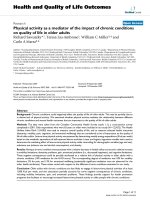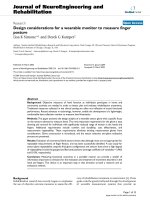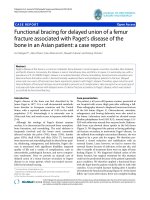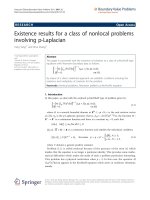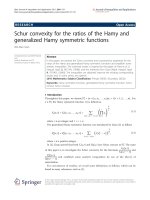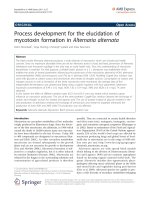Báo cáo hóa học: "MAXIMUM PRINCIPLES FOR A CLASS OF NONLINEAR SECOND-ORDER ELLIPTIC BOUNDARY VALUE PROBLEMS IN DIVERGENCE FORM CRISTIAN ENACHE " pptx
Bạn đang xem bản rút gọn của tài liệu. Xem và tải ngay bản đầy đủ của tài liệu tại đây (539.14 KB, 13 trang )
MAXIMUM PRINCIPLES FOR A CLASS OF NONLINEAR
SECOND-ORDER ELLIPTIC BOUNDARY VALUE
PROBLEMS IN DIVERGENCE FORM
CRISTIAN ENACHE
Received 22 January 2006; Accepted 26 March 2006
For a class of nonlinear elliptic boundary value problems in divergence form, we con-
struct some gener al elliptic inequalities for appropriate combinations of u(x)and
|∇u|
2
,
where u(x) are the solutions of our problems. From these inequalities, we derive, using
Hopf’s maximum principles, some maximum principles for the appropriate combina-
tions of u(x)and
|∇u|
2
, and we list a few examples of problems to which these maximum
principles may be applied.
Copyright © 2006 Cristian Enache. This is an open access article distributed under the
Creative Commons Attribution License, which per mits unrestricted use, distribution,
and reproduction in any medium, provided the original work is properly cited.
1. Introduction
Let u(x) be the classical solution of the following nonlinear boundary value problems:
g
u,
∇
u
2
u
,i
,i
+ h(x) f
u,|∇u|
2
=
0, x ∈Ω, (1.1)
u
= 0, x ∈ ∂Ω, (1.2)
where Ω is a bounded domain in
R
N
, N ≥ 2, with smooth boundary ∂Ω ∈C
2,ε
,and f , g,
and h are given functions assumed to satisfy the following conditions:
f ,h
≥ 0, g>0,
f ,h
∈ C
1
, g ∈C
2
.
(1.3)
Moreover, we assume that (1.1) is uniformly elliptic, that is, we impose throughout the
strong ellipticity condition
G(u,s):
= g(u,s)+2s
∂g
∂s
> 0, s>0, x
∈ Ω. (1.4)
Hindawi Publishing Corporation
Boundary Value Problems
Volume 2006, Article ID 64543, Pages 1–13
DOI 10.1155/BVP/2006/64543
2 Maximum principles for a class of elliptic problems
Under these assumptions, a minimum principle for the solutions u(x ) of the nonlinear
equation (1.1) follows immediately, that is, u(x) must assume its minimum value on ∂Ω.
Sufficient conditions on the data, for the existence of classical solutions of the non-
linear equation (1.1), are known and have been well studied in the literature. See, for
instance, Lady
ˇ
zenskaja and Ural’ceva [5] for an account on this topic. Consequently, we
will tacitly assume the existence of classical solutions of the problems considered in this
paper.
Maximum principles for some particular cases of the boundary value problems
(1.1)-(1.2) have been considered and investigated by various authors. For references on
these topics we refer, for instance, to Payne and Philippin [6, 7], to Enache and Philippin
[2], or to the book of Sperb [10]. In this paper, we will focus our attention on the follow-
ing two particular cases, which do not seem to have been considered in the literature: the
case g
= g(u), f = f (u), in Section 2, respectively, the case g = g(|∇u|
2
), f = f (|∇u|
2
),
in Section 3. In both cases, we will derive some maximum principles for appropriate com-
binations of u and
|∇u|
2
. These combinations will be of the following form:
Φ(x,a,b):
= g
2
(u)|∇u|
2
+2a
u
0
f (s)g(s)ds+2b
u
0
sg(s)ds, (1.5)
in Section 2,wherea and b are some real positive parameters to be appropriately chosen,
respectively,
Ψ(x,α,β):
=
|∇u|
2
0
G(s)
f (s)
ds+2αu + βu
2
, (1.6)
in Section 3,withG(s):
= g(s)+2sg
(s) > 0, where α and β are also some real positive
parameters to be appropriately chosen.
Here and in the rest of the paper, we adopt the following notations:
u
,i
:=
∂u
∂x
i
, u
,ij
:=
∂
2
u
∂x
i
∂x
j
. (1.7)
Moreover, we adopt the summation convention, that is, summation from 1 to N is un-
derstood on repeated indices. Using these notations, we have, for example,
u
,ij
u
,i
u
, j
=
N
i=1
N
j=1
∂
2
u
∂x
i
∂x
j
∂u
∂x
i
∂u
∂x
j
. (1.8)
2. Derivation of maximum principles for Φ
In this section, we focus our attention on the boundary value problems (1.1)-(1.2), with
g
= g(u)and f = f (u). Since the particular case h ≡ const has already been treated by
Payne and Philippin in [7], we consider only the general case when h(x) is a nonconstant
function.
Cristian Enache 3
Differentiating (1.5), we successively obtain
Φ
,k
= 2gg
|u|
2
u
,k
+2g
2
u
,ik
u
,i
+2afgu
,k
+2bugu
,k
, (2.1)
1
2
g(u)Φ
,k
,k
= g(g
)
2
|u|
4
+ g
2
g
|u|
4
−gg
hf|u|
2
+4g
2
g
u
,ik
u
,i
u
,k
+ g
2
gu
,ik
,k
u
,i
+ g
3
u
,ik
u
,ik
+ a
f
g + fg
g|u|
2
−af
2
gh+ bg
2
|u|
2
+ bgg
u|u|
2
−bu f gh.
(2.2)
Next, we differentiate (1.1)toobtain
g
u
,i
u
,k
+ gu
,ki
,k
=
gu
,k
,ki
=−h
,i
f −hf
u
,i
, (2.3)
from which we compute
gu
,ik
,k
u
,i
=−f ∇h∇u −hf
|∇u|
2
−g
|∇u|
4
−g
u
,ik
u
,k
u
,i
−g
|∇u|
2
Δu. (2.4)
Making use of the Cauchy-Schwarz inequality in the following for m:
|u|
2
u
,ik
u
,ik
≥ u
,ik
u
,k
u
,ij
u
, j
, (2.5)
and of (2.1), we obtain
u
,ik
u
,ik
≥
1
g
2
g
|∇u|
2
+(af + bu)
2
+ ,inΩω. (2.6)
In (2.6), ω :
={x ∈Ω : ∇u(x) =0} is the set of critical points of u and dots stand for terms
containing Φ
,k
.Wealsomakeuseof(2.1) to obtain the following identit y:
u
,ik
u
,i
u
,k
=−
1
g
g
|∇u|
2
+(af + bu)
|∇
u|
2
+ , (2.7)
where dots have the same meaning as above.
Next, using the differential equation (1.1)intheequivalentform
Δu
=−
hf
g
−
g
g
|∇u|
2
, (2.8)
and inserting (2.4), (2.6), (2.7), and (2.8)in(2.2), we obtain after some reductions that
the second-order differential operator
LΦ :
=
1
2
g(u)Φ
,k
,k
(2.9)
4 Maximum principles for a class of elliptic problems
satisfies the following inequality:
LΦ +
|∇u|
−2
W
k
Φ
,k
≥ g
2
(a −h) f
+ b
|∇
u|
2
− fh
,i
u
,i
+
1
g
(af +bu)
2
− fh(af + bu)
,inΩω,
(2.10)
where W
k
is the kth component of a vector field regular throughout Ω.
Now, we consider the following two inequalities:
(af +bu)
2
− fh(af + bu) ≥
a −
h
2
2
−
h
2
2
f
2
,
g
|∇u|
2
− fh
,i
u
,i
≥−
|∇
h|
2
f
2
4g
.
(2.11)
Using (2.11), we obtain, in Ω
ω, the following inequality:
LΦ +
|u|
−2
W
k
Φ
,k
≥ gf
2
a −
h
2
2
−
h
2
2
−
|∇
h|
2
4
, (2.12)
if b +(a
−h) f
≥ g. Consequently,
LΦ +
|u|
−2
W
k
Φ
,k
≥ 0, in Ωω, (2.13)
if the positive constants a and b are chosen to satisfy the following two conditions:
a
≥ max
Ω
h(x)
2
+
h
2
(x)
2
+
|∇h|
2
4
:= a
1
, (2.14)
b +(a
−h) f
≥ g. (2.15)
The following result is now a direct consequence of Hopf’s first maximum principle
[1, 3, 8, 9].
Theorem 2.1. Let u(x) be a classical solution of (1.1), with g
= g(u) and f = f (u),ina
bounded domain Ω
⊂ R
N
, N ≥ 2,andletΦ(x,a,b) be the function defined in (1.5). If the
positive parameters a and b are chosen to satisfy (2.14)-(2.15), then the function Φ(x,a,b)
takes its maximum value either on ∂Ω or at a crit ical point of u (i.e., a point in Ω where
∇u =0).
Remark 2.2. (i) In the case N
= 2, we may replace the inequality (2.5) by the following
identity:
u
,ik
u
,ik
|∇u|
2
=|∇u|
2
(Δu)
2
+2u
,i
u
,ij
u
,k
u
,kj
−2Δuu
,ij
u
,i
u
, j
. (2.16)
Cristian Enache 5
This identity leads to the same result if we replace the condition (2.14) by the following
one:
a
≥ max
Ω
3h(x)
4
+
10h
2
(x)
16
+
|∇h|
2
4
:=a
2
. (2.17)
(ii) The parameter b, satisfying (2.15), may be difficult to compute if g is not a bounded
function. However, there are situations when b could be taken to be 0. For instance when
f
> 0andg/ f
≤ M,withM a positive constant, the following choice for the real param-
eter a will be sufficient for the conclusion of Theorem 2.1:
a
≥ max
max
Ω
{h + M},max
Ω
h
2
+
h
2
2
+
|∇h|
2
4
. (2.18)
(iii) Theorem 2.1 holds independently of the boundary conditions for u(x). However,
in what follows, we will show that the maximum value of Φ(x,a,b) must occur at a critical
point of u,ifΩ is a convex domain in
R
N
.
Suppose that Φ(x,a,b) takes its maximum value at P on ∂Ω. Then, by Hopf’s second
maximum principle [4, 8], we must have Φ
≡ cte in Ω or ∂Φ/∂n > 0atP.Wenowcom-
pute the outward normal derivative ∂Φ/∂n at an arbitrary point of ∂Ω.Sinceu
= 0on
∂Ω,weobtain
∂Φ
∂n
= 2gg
u
3
n
+2g
2
u
nn
u
n
+2afgu
n
. (2.19)
From the differential equation (1.1), evaluated on ∂Ω
∈ C
2,ε
,wehave
g
u
2
n
+ g
u
nn
+(N −1)Ku
n
+ hf =0. (2.20)
In (2.19)and(2.20), u
n
and u
nn
are the first and second outward normal derivatives of u
on ∂Ω,andK is the average curvature of ∂Ω. The insertion of (2.20)in(2.19)leadsto
∂Φ
∂n
= 2 fg(a −h)u
n
−2(N −1)Kg
2
u
2
n
,on∂Ω. (2.21)
Clearly, if a satisfies (2.14)or(2.17), we have ∂Φ/∂n
≤ 0on∂Ω,sothatΦ cannot take
its maximum value on ∂Ω.Notethat
∇u = 0on∂Ω in view of Hopf’s second principle
[1, 4, 8, 9]. We formulate these results in the following theorem.
Theorem 2.3. Let u(x) be a classical solution of (1.1)-(1.2), with g
= g(u) and f = f (u)
in a bounded convex domain Ω
⊂ R
N
, N ≥ 2,andletΦ(x,a,b) be the function defined in
(1.5) with a and b as in Theorem 2.1. Then the function Φ(x , a,b) takes its maximum value
at a critical point of u.
6 Maximum principles for a class of elliptic problems
Remark 2.4. (i) Theorems 2.1 and 2.3 also hold in the case f (s)
≤ 0, s>0.
(ii) Theorem 2.3 requires that Ω be a convex domain. This restriction can, of course,
be relaxed requiring that at each point of ∂Ω, the average curvature is nonnegative.
3. Derivation of maximum principles for Ψ
In this section, we focus our attention on the boundary value problems (1.1)-(1.2), with
g
= g(|∇u|
2
)and f = f (|∇u|
2
). Since the particular case h ≡ const has already been
treated by Payne and Philippin in [6], we consider only the general case when h(x)is
a nonconstant function.
From (1.6), we successively compute
Ψ
,k
= 2
G
f
u
,ik
u
,i
+2αu
,k
+2βuu
,k
, (3.1)
Ψ
,kj
= 4
G
f
−
f
f
2
G
u
,ik
u
,i
u
,lj
u
,l
+2
G
f
u
,ik j
u
,i
+ u
,ik
u
,ij
+2αu
,kj
+2βu
, j
u
,k
+2βuu
,kj
,
(3.2)
ΔΨ
= 4
G
f
−
f
f
2
G
u
,ik
u
,i
u
,lk
u
,l
+2
G
f
(Δu)
,i
u
,i
+ u
,ik
u
,ik
+2αΔu +2β|∇u|
2
+2βuΔu.
(3.3)
Next, we replace Δu and (Δu)
,i
u
,i
in (3.3) using the differential equation (1.1)inthe
equivalent form
Δu
=−2
g
g
u
,lk
u
,l
u
,k
−
hf
g
. (3.4)
Differentiating (3.4), we obtain
(Δu)
,i
u
i
=−4
g
g
u
,lk
u
,l
u
,k
2
−2
g
g
u
,ilk
u
,l
u
,k
u
,i
+2u
,lk
u
,li
u
,k
u
,i
−
f
g
h
,i
u
,i
−h
f
g
2u
,ik
u
,k
u
,i
+2
g
g
2
hfu
,ik
u
,k
u
,i
.
(3.5)
Now, we would like to construct a second-order elliptic differential inequality for Ψ
that contains no third-order derivatives of u. This will be achieved if we consider the
following operator:
LΨ :
= ΔΨ +2
g
g
Ψ
,kj
u
,k
u
, j
, (3.6)
Cristian Enache 7
for which we obtain after some reductions
LΨ
= 2
G
f
u
,ik
u
,ik
+4
G
f
−
f
f
2
G −
G
f
g
g
u
,ik
u
,i
u
,lk
u
,l
+8
g
g
G
f
−
f
f
2
G
−
G
f
g
g
u
,lk
u
,l
u
,k
2
+4h
G
g
g
g
−
f
f
u
,ik
u
,i
u
,k
−2
G
g
h
,i
u
,i
−2(α + βu)
hf
g
+2β
G
g
|∇u|
2
.
(3.7)
Making use of (3.1), we now compute
u
,ik
u
,i
u
,k
=−(α + βu)
f
G
|u|
2
+ ,
u
,ik
u
,i
u
,k
2
= (α + βu)
2
f
2
G
2
|u|
4
+ ,
(3.8)
u
,ik
u
,i
u
,lk
u
,l
= (α + βu)
2
f
2
G
2
|u|
2
+ , (3.9)
where dots stand for terms containing Ψ
,k
. Combining (3.9)with(2.5), we obtain the
inequality
u
,ik
u
,ik
≥ (α + βu)
2
f
2
G
2
+ ,inΩω, (3.10)
where ω :
={x ∈ Ω : ∇u(x) =0} is the set of critical points of u and dots have the same
meaning as above.
It then follows from (3.7), (3.8), (3.9), and (3.10) that the following inequality holds:
LΨ +
|∇u|
−2
W
k
Ψ
,k
≥
2G
g
β −2
f
G
(α + βu)
2
−(α + βu)h
|∇
u|
2
−h
,i
u
,i
+
f
g
(α + βu)
2
−(α + βu)h
,inΩω,
(3.11)
where W
k
is the kth component of a vector field regular throughout Ω.
Now, we consider the following two inequalities:
(α + βu)
2
−h(α + βu) ≥
α −
h
2
2
−
h
2
2
,
g
f
|∇u|
2
−∇h∇u ≥−
f
4g
|∇h|
2
.
(3.12)
Inserting (3.12)in(3.11), we obtain, in Ω
ω, the following inequality:
LΨ +
|u|
−2
W
k
Ψ
,k
≥
2G
g
2
2
f
α −
h
2
2
−
h
2
2
−
|∇
h|
2
4
, (3.13)
8 Maximum principles for a class of elliptic problems
valid if β
≥ g/f and f
≤ 0. Consequently,
LΨ +
|u|
−2
W
k
Ψ
,k
≥ 0, in Ωω, (3.14)
if the positive constants α and β are chosen to satisfy the following two conditions:
α
≥ max
Ω
h(x)
2
+
h
2
(x)
2
+
|∇h|
2
4
:= α
1
, (3.15)
β
≥ max
Ω
g
f
+
f
G
|∇h|
2
2
, (3.16)
and the function f satisfies
f
≤ 0. (3.17)
The following result is now a direct consequence of Hopf’s first maximum principle
[1, 3, 8, 9].
Theorem 3.1. Let u(x) beaclassicalsolutionof(1.1), with g
= g(|∇u|
2
) and f =
f (|∇u|
2
), in a bounded domain Ω ⊂R
N
, N ≥ 2,andletΨ(x,α,β) be the function defined
in (1.6). If the positive parameters α and β are chosen to satisfy (3.15)-(3.16)and f satisfies
(3.17), then the funct ion Ψ(x,α,β) takes its maximum value either on ∂Ω or at a critical
point of u (i.e., a point in Ω where
∇u =0).
Remark 3.2. (i) The parameter β, satisfying (3.16), may be difficult to compute if g/ f is
not a bounded function.
(ii) Theorem 3.1 holds independently of the boundary conditions for u(x). However,
in what follows, we will show that the maximum value of Ψ(x,α,β) must occur at a critical
point of u,ifΩ is a convex domain in
R
N
.
Suppose that Ψ(x,α,β) takes its maximum value at P on ∂Ω. Then, by Hopf’s second
maximum principle [4, 8], we must have Ψ
≡ cte in Ω or ∂Ψ/∂n > 0atP.Wenowcom-
pute the outward normal derivative ∂Ψ/∂n at an arbitrary point of ∂Ω.Sinceu
= 0on
∂Ω,weobtain
∂Ψ
∂n
= 2
G
f
u
n
u
nn
+2αu
n
. (3.18)
From the differential equation (1.1), evaluated on ∂Ω
∈ C
2,ε
,wehave
Gu
nn
+ g(N −1)Ku
n
+ hf =0. (3.19)
In (3.18)and(3.19), u
n
and u
nn
are the first and second outward normal derivatives of u
on ∂Ω,andK is the average curvature of ∂Ω. The insertion of (3.19)in(3.18)leadsto
∂Ψ
∂n
=−2
g
f
(N
−1)Ku
2
n
+2(α−h)u
n
,on∂Ω. (3.20)
Cristian Enache 9
Clearly, if α satisfies (3.15), we have ∂Ψ/∂n
≤ 0on∂Ω,sothatΨ cannot take its maximum
value on ∂Ω.Notethat
∇u = 0on∂Ω in view of Hopf’s second principle [1, 4, 8, 9]. We
formulate these results in the following theorem.
Theorem 3.3. Let u(x) be a c lassical solution of (1.1)-(1.2), with g
= g(|∇u|
2
) and f =
f (|∇u|
2
), in a bounded convex domain Ω ⊂R
N
, N ≥ 2,andletΨ(x,α,β) be the function
defined in (1.6)withα and β as in Theorem 3.1. Then the function Ψ(x,α,β) takes its max-
imum value at a critical point of u.
4. Examples
In this section, we list a few examples of problems for which the maximum principles
obtained in the Theorems 2.3 and 3.3 may be applied. In general, we would expect the
maximum principle derived for Φ(x, a,b), respectively, Ψ(x,α, β), to y ield upper bounds
for solutions, for the magnitude of its gradient, or for the distance from a critical point
of solution to the boundary of the domain Ω, assumed to be bounded and convex in
R
N
,
N
≥ 2, with smooth boundary ∂Ω ∈C
2,ε
.
Example 4.1. Let u(x) be the classical solution of the boundary value problem
Δu + p
|∇u|
2
+ h(x) =0, x ∈Ω, (4.1)
u
= 0, x ∈ ∂Ω, (4.2)
where p
= const > 0(thecasep =0 was studied in [2]) and h ∈C
1
(Ω) is a nonnegative
function satisfying the following condition:
a :
= max
max
Ω
h +
1
p
,max
Ω
h
2
+
h
2
2
+
|∇h|
2
4
<
π
4d
2
p
, (4.3)
where d is the radius of the largest ball inscribed in Ω.
Multiplying (4.1)bye
pu
we obtain
e
pu
u
,i
,i
+ e
pu
h(x) =0, (4.4)
that is, (1.1)with f (u)
= g(u) =e
pu
. Theorem 2.3 implies that the auxiliary function
Φ(x,a,0)
= e
2pu
|∇u|
2
+
a
p
e
2pu
−1
(4.5)
takes its maximum value at a critical point of u. This leads to the following inequality:
e
2pu
|∇u|
2
≤
a
p
e
2pu
m
−e
2pu
, (4.6)
where u
m
:= max
Ω
u(x). Inequality (4.6) may be used to derive an upper bound for u
m
.
To this end, let P be a point where u
= u
m
and Q a point on ∂Ω nearest to P.Letr measure
10 Maximum principles for a class of elliptic problems
the distance from P along the ray connecting P and Q.Clearly,wehave
−
du
dr
≤|∇u|. (4.7)
Integrating (4.7)fromQ to P and making use of (4.6), we obtain
u
m
0
e
pu
du
√
e
2pu
m
−e
2pu
≤
a
p
Q
P
dr =
a
p
δ
≤
a
p
d, (4.8)
where δ
= d(P,Q), We obtain
u
m
≤
1
p
log
1
cos(
√
apd)
, (4.9)
and, consequently,
|∇u|
2
≤
a
p
1
cos
2
(
√
apd)
−1
. (4.10)
Example 4.2. Let u(x) be the classical solution of the boundary value problems
uΔu + p
|∇u|
2
+ h(x)u
2
= 0, x ∈ Ω, (4.11)
u
= 0, x ∈ ∂Ω, (4.12)
where p
= const ∈(−1,1) and h ∈C
1
(Ω) is a nonnegative function.
Multiplying (4.11)byu
p−1
,weobtain
u
p
u
,i
,i
+ h(x)u
p+1
= 0, (4.13)
that is, (1.1)with f (u)
= u
p+1
, g(u) =u
p
. Theorem 2.3 implies that the auxiliary function
Φ(x,a,0)
= u
2p
|∇u|
2
+
a
p +1
u
2p+2
, (4.14)
with
a :
= max
max
Ω
h +
1
p +1
,max
Ω
h
2
+
h
2
2
+
|∇h|
2
4
(4.15)
takes its maximum value at a critical point of u. This leads to the following inequality:
u
2p
|∇u|
2
≤
a
p +1
u
2p+2
m
−u
2p+2
, (4.16)
Cristian Enache 11
where u
m
:= max
Ω
u(x). Integrating (4.16) in the same way as in the previous examples,
we obtain
π
2(p +1)
=
u
m
0
u
p
du
u
2p+2
m
−u
2p+2
≤
a
p +1
δ, (4.17)
where δ
= d(P, Q). This shows that the cri tical points of u(x) are at distance δ ≥ π/
2
(p +1)a from the boundary.
Example 4.3. Let u(x) be the classical solution of the boundary value problems
u
,i
1+|∇u|
2
,i
+ h(x)
1
1+|∇u|
2
= 0, x ∈ Ω,
u
= 0, x ∈ ∂Ω,
(4.18)
where h
∈ C
1
(Ω) is a nonnegative function satisfying the following conditions:
|∇h|
2
≥ 4,
α :
= max
Ω
h
2
+
h
2
2
+
|∇h|
2
4
<
π
2d
(4.19)
where d is the radius of the largest ball inscribed in Ω.
In this case, we have (1.1)withg(
|∇u|
2
) = f (|∇u|
2
) = (1 + |∇u|
2
)
−1/2
. Theorem 3.3
implies that the auxiliar y function
Ψ(x,α,0)
= log
1+|∇u|
2
+2αu, (4.20)
takes its maximum value at a critical point of u. This leads to the following inequality:
log
1+|∇u|
2
≤
2α
u
m
−u
(4.21)
or
e
2αu
|∇u|
2
≤ e
2αu
m
−e
2αu
, (4.22)
where u
m
:= max
Ω
u(x). Integrating (4.22), as in the previous applications, we obtain
u
m
≤
1
α
log
1
cos(αd)
(4.23)
and, consequently,
|∇u|
2
≤ tan(αd). (4.24)
12 Maximum principles for a class of elliptic problems
Example 4.4. Let u(x) be the classical solution of the boundary value problems
exp
1
1+|∇u|
2
u
,i
,i
+ h(x)exp
1
1+|∇u|
2
=
0, x ∈Ω,
u
= 0, x ∈ ∂Ω,
(4.25)
where h
∈ C
1
(Ω) is a nonnegative function and d, the radius of the largest ball inscribed
in Ω, satisfies
d<
π
2
√
2
. (4.26)
In this case, we have (1.1)withg(
|∇u|
2
) = f (|∇u|
2
) =exp(1/(1 + |∇u|
2
)). Theorem 3.3
implies that the auxiliar y function
Ψ(x,α,1)
=
|∇u|
2
0
s
2
+1
(s +1)
2
ds+2αu + u
2
(4.27)
takes its maximum value at a critical point of u if the parameter α is chosen to satisfy
α
≥ max
Ω
h(x)
2
+
h
2
(x)
2
+
|∇h|
2
4
. (4.28)
This leads to the following inequality:
1
2
|∇u|
2
≤
|∇u|
2
0
s
2
+1
(s +1)
2
ds ≤ 2α
u
m
−u
+
u
2
m
−u
2
=
u
m
+ α
2
−(u + α)
2
,
(4.29)
where u
m
:= max
Ω
u(x). Integrating (4.29) in the same way as in the previous applica-
tions, we obtain the following upper bound for u
m
:
u
m
≤ α
1
cos(d
√
2)
−1
. (4.30)
Acknowledgment
The author is very grateful to G. A. Philippin for his useful comments and suggestions.
References
[1] Y. Du, Order Structure and Topological Methods in Nonlinear Partial Differential Equations, Vol 1:
Maximum Principles and Applications, World Scientific, New Jersey, 2006.
[2] C. Enache and G. A. Philippin, Some maximum principles for a class of elliptic boundary value
problems, to appear in Mathematical Inequalities & Applications.
[3] E. Hopf, Elementare bemerkung
¨
uber die l
¨
osung partieller differentialgleichungen zweiter ordnung
vom elliptisc hen typus, Sitzungsberichte Preussiche Akademie Wissenschaften 19 (1927), 147–
152.
Cristian Enache 13
[4] , A remark on linear elliptic differential equations of second order, Proceedings of the
American Mathematical Society 3 (1952), 791–793.
[5] O. A. Lady
ˇ
zenskajaandN.N.Ural’ceva,
´
Equations aux D
´
eriv
´
ees Partielles de Type Elliptique,
Monographies Universitaires de Math
´
ematiques, no. 31, Dunod, Par is, 1968.
[6] L. E. Payne and G. A . Philippin, Some maximum principles for nonlinear elliptic equations in
divergence form with applications to capillary surfaces and to surfaces of constant mean curvature,
Nonlinear Analysis 3 (1979), no. 2, 193–211.
[7]
, On maximum principles for a class of nonlinear second-order elliptic equations,Journal
of Differential Equations 37 (1980), no. 1, 39–48.
[8] M.H.ProtterandH.F.Weinberger,Maximum Principles in Differential Equations, Springer,
New York, 1975.
[9] P. Pucci and J. Serrin, The strong maximum principle revisited,JournalofDifferential Equations
196 (2004), no. 1, 1–66.
[10] R. P. Sperb, Maximum Principles and Their Applications, Mathematics in Science and Engineer-
ing, vol. 157, Academic Press, New York, 1981.
Cristian Enache: Department of Mathematics and Computer Science, Ovidius University,
900 527 Constanta, Romania
E-mail address:

